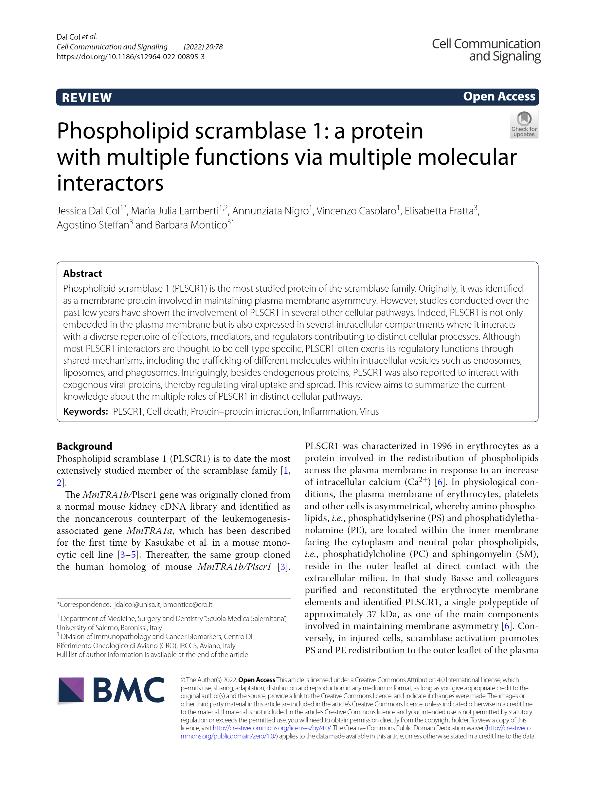Artículo
Phospholipid scramblase 1: A protein with multiple functions via multiple molecular interactors
Dal Col, Jessica; Lamberti, María Julia ; Nigro, Annunziata; Casolaro, Vincenzo; Fratta, Elisabetta; Steffan, Agostino; Montico, Barbara
; Nigro, Annunziata; Casolaro, Vincenzo; Fratta, Elisabetta; Steffan, Agostino; Montico, Barbara
 ; Nigro, Annunziata; Casolaro, Vincenzo; Fratta, Elisabetta; Steffan, Agostino; Montico, Barbara
; Nigro, Annunziata; Casolaro, Vincenzo; Fratta, Elisabetta; Steffan, Agostino; Montico, Barbara
Fecha de publicación:
06/2022
Editorial:
BioMed Central
Revista:
Cell Communication and Signaling
e-ISSN:
1478-811X
Idioma:
Inglés
Tipo de recurso:
Artículo publicado
Clasificación temática:
Resumen
Phospholipid scramblase 1 (PLSCR1) is the most studied protein of the scramblase family. Originally, it was identified as a membrane protein involved in maintaining plasma membrane asymmetry. However, studies conducted over the past few years have shown the involvement of PLSCR1 in several other cellular pathways. Indeed, PLSCR1 is not only embedded in the plasma membrane but is also expressed in several intracellular compartments where it interacts with a diverse repertoire of effectors, mediators, and regulators contributing to distinct cellular processes. Although most PLSCR1 interactors are thought to be cell-type specific, PLSCR1 often exerts its regulatory functions through shared mechanisms, including the trafficking of different molecules within intracellular vesicles such as endosomes, liposomes, and phagosomes. Intriguingly, besides endogenous proteins, PLSCR1 was also reported to interact with exogenous viral proteins, thereby regulating viral uptake and spread. This review aims to summarize the current knowledge about the multiple roles of PLSCR1 in distinct cellular pathways. [MediaObject not available: see fulltext.].
Palabras clave:
PLSCR1
,
Protein?protein interaction
,
Cell death
,
Infammation
,
Virus
Archivos asociados
Licencia
Identificadores
Colecciones
Articulos (INBIAS)
Articulos de INSTITUTO DE BIOTECNOLOGIA AMBIENTAL Y SALUD
Articulos de INSTITUTO DE BIOTECNOLOGIA AMBIENTAL Y SALUD
Citación
Dal Col, Jessica; Lamberti, María Julia; Nigro, Annunziata; Casolaro, Vincenzo; Fratta, Elisabetta; et al.; Phospholipid scramblase 1: A protein with multiple functions via multiple molecular interactors; BioMed Central; Cell Communication and Signaling; 20; 1; 6-2022; 78-93
Compartir
Altmétricas



